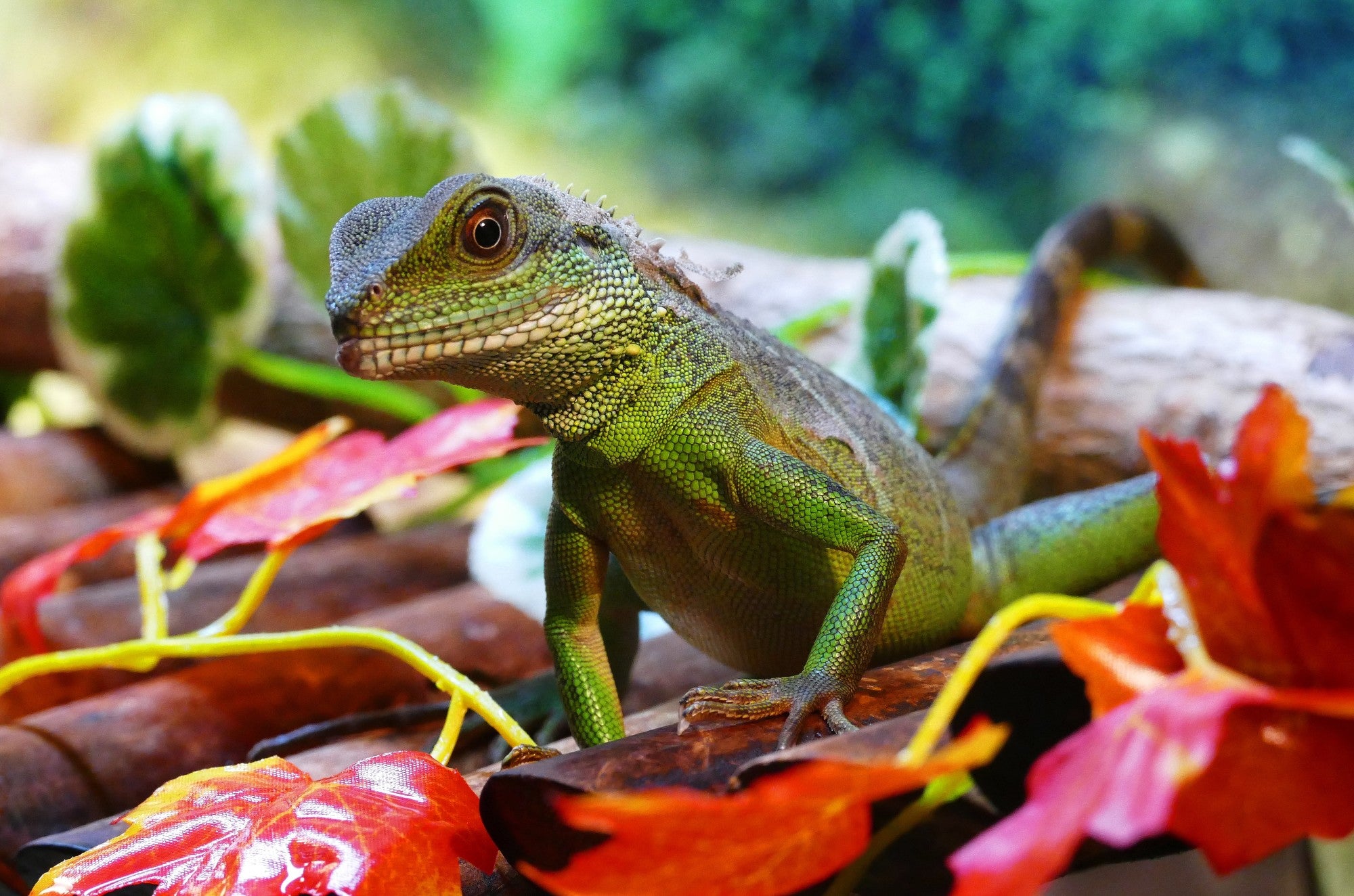Over the last decade or so, reptile ownership has more than doubled in the US. Recent figures show that 4.5 percent of American households now include at least one pet reptile.
Caring for any pet means providing them with a balanced diet full of nutrients. But while we're all familiar with cat and dog food, what do reptiles eat? One big difference between reptiles and more traditional pets like cats and dogs is that live feeding is often necessary to ensure the optimal health of your pet reptile.
With more than 10,000 different reptile species out there, though, you'll find that reptile diets can vary a lot. And especially when you're comparing feeding lizards to feeding snakes, chameleons, or turtles.
But is live food for reptiles always better? Or does it depend on certain factors? Let's take a look at different reptiles and consider the pros and cons of giving them live food.
Snakes
All snakes are carnivores but their exact diet depends on their species. Some eat warm-blooded prey such as rabbits, birds, and rodents. Others prefer insects, other reptiles, frogs and toads, eggs, fish, worms, and slugs.
Some of the best pet snakes include corn snakes, California kingsnakes, rhino rat snakes, and ball pythons for their docile natures. All of these varieties primarily eat rodents, although California kingsnakes will also eat lizards, frogs, and even other snakes.
When it comes to feeding your pet snake, though, most resources argue against giving them live food.
Snakes living in the wild will often scavenge road kill and dead animals. And even snake species that tend to prefer live prey can be trained to accept pre-killed animals. As such, going to the effort of providing your pet snake with suitable live reptile food such as rodents is unnecessary and can even be dangerous.
There is always a chance that living mice and other live prey may fight back when the snake is feeding on them. The tiny rodent's sharp teeth and claws could cause severe injuries and infections to your pet snake.
What's more, caged snakes may not be as skilled as wild snakes when it comes to hunting, causing them to struggle when trying to kill live prey. A far safer and easier option is to serve thawed frozen mice or rat Dubi Dogz to your pet snake.
Turtles
Although there are many different kinds of turtles, you'll find that only a few species will take live food. None eat live rodents and those who do like live feed tend to enjoy earthworms and black soldier fly larvae the best. In general, turtles are poor hunters who are happy to eat prepared turtle food, pieces of pre-killed fish, and vegetables.
One exception is the mata mata turtle, which will only eat live fish and tadpoles. But they tend to be less popular as pets for this reason.
Right at the other end of the scale is the Russian tortoise - a large herbivorous species of turtle. In the wild, these tortoises eat anything from leafy greens to dry grass. As pets, they'll need a diet high in plant fibers and enough fresh greens and hay to satisfy their habit of constant grazing.
Box turtles are quite small and easy to care for, making them great pets and one of the most popular pet reptile options in the US. They are omnivores though, meaning that they need a combination of both plant matter and insect or animal protein.
As a rule, their preference is a 50/50 divide. But you won't need to buy live insects to ensure that they get enough animal protein. As land animals who aren't good hunters, box turtles do better with dried bugs and love to snack on thawed frozen snails.
Lizards
Geckos, iguanas, chameleons, and more all come under the broad category of "lizard." As such, you'd be correct in thinking that there is a lot of dietary variation here.
Green iguanas, for example, are herbivorous reptiles that only eat plants. In the wild, you'll mostly see them munching on leaves and foliage as well as some fruits and flowers. That said, while they might have a simple diet, their space requirements and preference for a tropical climate make them less than ideal as pets.
In contrast, most geckos, monitor lizards, and chameleons are carnivores or insectivores. And then there are many omnivorous lizards - such as day geckos and bearded dragons - that will eat a combination of plants and insects or animal protein.
But thanks to the availability of excellent quality live food, many types of lizards are simple to look after. Here are some of the most popular lizard pets and their live food requirements.
Monitor Lizards
Many insect-eating lizards need movement to stimulate their desire to feed. This makes live insects the best choice for bearded dragons, leopard geckos, and the like. But monitor lizards are a little different as they eat rodents and will accept pre-killed frozen mice without any problems.
Rather than buying large frozen mice and offering cut-up sections, you should offer your pet monitor lizard smaller mice that can be eaten whole in one feeding. This allows your pet to consume the entire animal, including the bones, skin, and internal organs. These parts provide essential nutrients for your pet's health and will ensure that they live as long as 30 years.
Bearded Dragons
As mentioned above, bearded dragons are omnivores that need to feed on live insects such as crickets, locusts, and small Dubia nymphs as well as greens. For reference, your dragon's live food should be no bigger than the distance between its eyes. This avoids the potential for any digestive issues.
The age of your bearded dragon also dictates what kind of diet to feed them. Young bearded dragons need more live food than older ones, preferring a combination of 65 percent live food and 35 percent greens. Adult dragons should eat 40 live food and 60 percent greens.
Releasing live food into your bearded dragon's home encourages its innate urge to hunt down its prey as it would in its natural environment. This activity also provides your pet with the necessary stimulation for a long and happy life.
The best time to release live food for these reptiles is in the morning. This way your dragon has the rest of the day to digest its food. Once it's finished eating and shows no interest in more hunting, remove any uneaten bugs to stop them from annoying your pet (dubia roaches don't bother your pet)
Leopard Geckos
The movement of live prey also attracts leopard geckos and stimulates both their natural hunting instincts and their appetite. Luckily, leopard geckos are simple to look after and will eat all kinds of live insects, including mealworms, waxworms, and Dubia roaches.
As with bearded dragons, when feeding lizards such as leopard geckos, you should not feed them live food that's bigger than the distance between their eyes. One difference is that leopard geckos are crepuscular. This means that they prefer to hunt out in the wild once the sun starts to set. Feed them in the early evening and dim the lights to ensure that your home accommodates their natural preferences.
Chameleons
In the wild, most chameleons enjoy an insectivore diet, although larger species will also eat birds such as quails and small lizards. It's also quite common for some chameleons - including the veiled chameleon- to supplement their diet with leafy greens such as kale and collard greens.
To keep your pet chameleon happy and mimic its natural habitat, you'll need to provide it with a wide variety of live insects. Although they're not fast movers, chameleons love to hunt down insects by watching their movements with sharp eyes and capturing their prey with their long and sticky tongues.
Some of their favorite insects to hunt include silkworms, grasshoppers, crickets, locusts, mealworms, silkworms, and roaches.
Blue-Tongued Skinks
Blue-tongued skinks are an often overlooked option for a lizard pet. But they're actually easy to look after as they're omnivores that will eat a wide variety of foods once they reach their adult stage. Adult skinks mostly eat greens and vegetables, as well as small amounts of fruits and insect or animal protein.
If you get a baby blue-tongued skink as a pet though, you'll need to feed it live bugs such as mealworms and crickets. Giving your pet an abundance of insect protein when it's young will ensure that it'll grow up to be a stronger and healthier adult.
Your Guide to the Live Feeding Requirements of Reptiles
As this guide shows, many different kinds of reptiles do need a regular supply of live food. If you're considering getting a pet reptile - including many types of lizards and some turtles - this is something you'll have to commit to in the long term.
For those of you who aren't keen on the idea of live feeding a reptile, keeping a pet snake could be the better choice as they're happy with thawed frozen mice. Or, if you'd prefer a herbivorous reptile, an iguana or Russian turtle might be your best bet.
Make sure to subscribe to our newsletter for regular Dubi Deli updates. Or, for more information, feel free to contact us with any questions about live feeding, Dubia care, and more!

